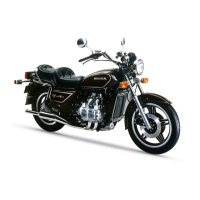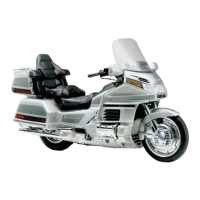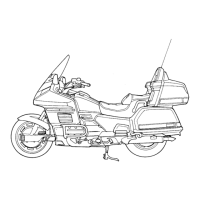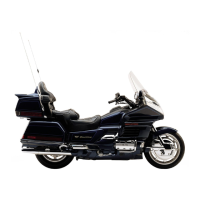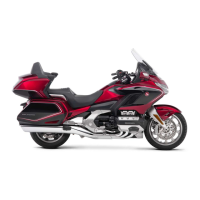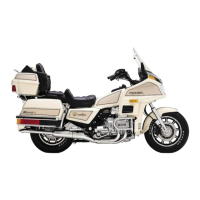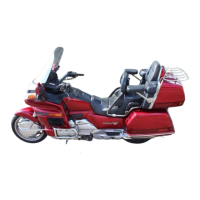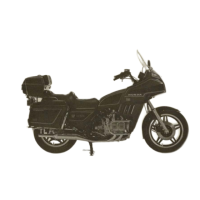
Do you have a question about the Honda Goldwing F6B and is the answer not in the manual?
| Engine Type | 1832cc liquid-cooled horizontally opposed six-cylinder |
|---|---|
| Bore and Stroke | 74mm x 71mm |
| Compression Ratio | 9.8:1 |
| Fuel System | Programmed Fuel Injection (PGM-FI) |
| Ignition | Computer-controlled digital with three-dimensional mapping |
| Final Drive | Shaft |
| Front Tire | 130/70R-18 |
| Rear Tire | 180/60R-16 |
| Wheelbase | 66.5 inches |
| Seat Height | 28.5 inches |
| Fuel Capacity | 6.6 gallons |
| Curb Weight | 842 pounds |
| Transmission | Five-speed including Overdrive |
| Front Suspension | 45mm fork; 4.8 inches travel |
| Rear Suspension | Pro-Link single shock with hydraulic spring preload adjustment; 4.1 inches travel |
| Front Brakes | Dual 296mm discs with CBS three-piston calipers |
| Rear Brakes | Single 316mm disc with CBS three-piston caliper |
Motorcycle capacity and weight limits.
Motorcycle usage restricted to roads.
Emphasizes reading the manual for safety.
Explains symbols and meanings on safety labels.
Discusses danger, warning, and caution messages.
General advice for safe motorcycle operation.
Recommendations for riding gear like helmets, boots, and gloves.
Information on motorcycle weight capacity and cargo loading.
Explanation of symbols and meanings on various motorcycle labels.
Locations and meanings of safety labels on the motorcycle.
Identifies controls on the left and right handlebars.
Locates ignition switch and other dashboard controls.
Shows speed and engine RPM.
Explains warning and indicator lights like ABS, MIL, etc.
Displays fuel level and engine coolant temperature.
Describes startup and shutdown display animations.
How to adjust screen brightness.
Steps to set the hour and minute.
Displays current ambient air temperature.
Indicates if motorcycle saddlebags are open.
Checking and maintaining front brake fluid level.
How to adjust the distance of the brake lever.
Checking and maintaining rear brake fluid level.
Checking and maintaining clutch fluid level.
How to adjust the distance of the clutch lever.
Type of coolant and maintenance advice.
Procedure for checking coolant level in the reserve tank.
Fuel tank capacity and refueling instructions.
Use of unleaded petrol and octane rating.
Guidelines for using gasohol and ethanol/methanol blends.
Procedure for checking engine oil level.
Importance of proper tire inflation for handling and safety.
Checking tires for damage, wear, and foreign objects.
Procedures for repairing or replacing tires.
Operation and key positions of the ignition switch.
Information about the motorcycle keys and key number plate.
Details on the Honda Ignition Security System.
Controls located on the right handlebar grip.
Controls located on the left handlebar grip.
How to lock and unlock the steering.
Instructions for using the helmet holder.
Information on saddlebag capacity and locking mechanism.
Usage and cargo limits for fairing pockets and cases.
Storage location for the owner's manual and other documents.
Procedure for adjusting headlight beam angle.
Location and use of the accessory power terminal.
Overview and features of the motorcycle's audio system.
Operation of the radio and antenna.
Connecting and using external audio devices.
Playing music files from iPods and USB drives.
System control and operation for passenger communication.
Essential checks before riding the motorcycle.
Procedures for starting the engine and handling flooded engines.
Recommendations for the initial 500 km break-in period.
Basic riding techniques and gear shifting.
Operation of the Dual CBS and ABS braking systems.
Instructions for safely parking the motorcycle.
Measures to prevent motorcycle theft.
Why regular maintenance is crucial for safety and performance.
General safety precautions for maintenance tasks.
Specific hazards and precautions during maintenance.
Recommended service intervals and tasks.
Contents of the onboard tool kit.
Location of frame and engine serial numbers.
Location of the color code label for replacement parts.
Procedures for removing various motorcycle covers.
Instructions for removing front and rear wheels.
Oil recommendations, viscosity, and change procedures.
Maintenance of the crankcase breather tube.
Recommended spark plugs and replacement procedure.
Coolant replacement procedures and warnings.
Checking fork, swingarm, and suspension fasteners.
How to check and replace brake pads.
Functional check of the side stand and its safety system.
Procedure for inspecting the brake system.
Battery type, maintenance, and replacement.
How to check and replace fuses.
Procedures for replacing various light bulbs.
General instructions for cleaning the motorcycle.
Using polish, wax, and removing road salt.
Cleaning painted aluminum wheels.
How to clean the motorcycle's windscreen.
Cleaning the instrument display and light lenses.
Steps to prepare the motorcycle for extended storage.
Procedures for taking the motorcycle out of storage.
Actions to take after a motorcycle crash.
Overall physical measurements of the motorcycle.
Fluid capacities and load limits.
Engine specifications like bore, stroke, and displacement.
Details on caster, trail, and tyre specifications.
Gear ratios and drive system specifications.
Battery and generator specifications.
Specifications for headlight, brake, and signal bulbs.
Electrical fuse types and ratings.
